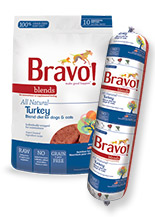Bravo Blends Turkey Review
PawDiet has been helping pet owners since 2015. To fund our efforts, articles may include affiliate links; if you buy something through a link, we may earn a commission.
Review of Bravo Blends Turkey
According to our most recent data, this product is intended for intermittent or supplemental feeding only.
Review of Ingredients
In our review of Bravo Blends Turkey, we'll examine all 8 ingredients and highlight the nutritional contribution of each ingredient.
While the first few ingredients typically dominate the recipe's composition, ingredients in small quantities can still have a meaningful impact on the overall nutritional profile of the recipe.
Turkey is a lean, highly digestible protein source that provides essential amino acids, vitamins, and minerals for your cat's overall health and well-being.
Turkey Bone provides a natural source of calcium and phosphorus, which are essential minerals for maintaining strong and healthy bones and teeth in your cat.
Turkey Heart is a nutrient-dense organ meat that provides essential amino acids, vitamins, and minerals, promoting your cat's overall health and well-being.
Turkey Gizzard is a nutrient-dense organ meat providing high-quality protein and essential nutrients like iron and zinc, supporting your cat's overall health.
Turkey Liver is a nutrient-rich organ meat that provides an excellent source of protein, vitamins, and minerals to support your cat's overall health and well-being.
Green Beans are a low-calorie, nutrient-rich ingredient that provides your cat with essential vitamins, minerals, and dietary fiber. They are an excellent source of vitamin C, vitamin K, and manganese, which support your cat's immune system, bone health, and digestion.
Squash is a nutritious vegetable ingredient that provides your cat with essential vitamins, minerals, and fiber. It is particularly rich in beta-carotene, which supports healthy vision and a strong immune system.
While cats are obligate carnivores, small amounts of vegetables like broccoli can provide additional nutrients and fiber, potentially aiding in digestion and overall health.
Review of Guaranteed Analysis
Crude Protein (min) of 14.00%: The primary contributors to the crude protein content in this pet food are the turkey-based ingredients. Turkey meat itself is a rich source of protein, as are the turkey heart and turkey gizzard. These are all muscle-based components, which naturally contain high levels of protein. The turkey liver also contributes to the protein content, although it is also a source of vitamins and minerals.
Crude Fat (min) of 14.00%: The crude fat content is likely derived from the turkey skin and darker meat cuts included in the product, as these tend to be higher in fat. Additionally, the turkey heart and liver can contribute to the overall fat content. Animal tissues, especially those from birds like turkey, are known to contain a significant amount of fat, which is essential for a pet's diet, providing energy and aiding in the absorption of fat-soluble vitamins.
Crude Fiber (max) of 1.00%: The crude fiber content is relatively low in this pet food, which is consistent with a diet high in animal-based ingredients. The fiber that is present likely comes from the green beans, squash, and broccoli included in the blend. These vegetables are known sources of dietary fiber, which is important for digestive health. However, since they are not the main ingredients and are present in smaller quantities compared to the turkey components, the overall fiber content remains low.
Calories of 1808.00 per kg: The caloric content is a measure of the energy provided by the food. In this case, the calories are derived from the macronutrients in the food: protein, fat, and carbohydrates. The turkey meat and organs provide a substantial amount of calories from protein and fat, while the vegetables contribute a smaller amount from their carbohydrate content. Given that both protein and fat are calorie-dense nutrients, with fat providing more than twice the calories per gram compared to protein or carbohydrates, the equal crude protein and crude fat percentages suggest that a significant portion of the calories comes from fat.

